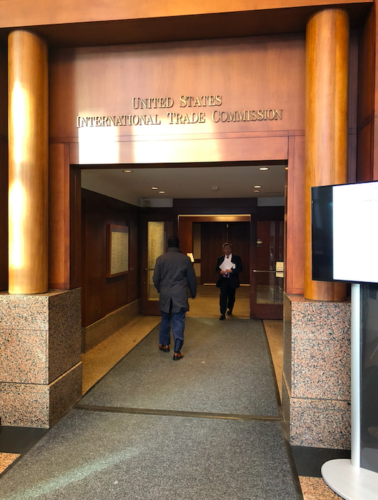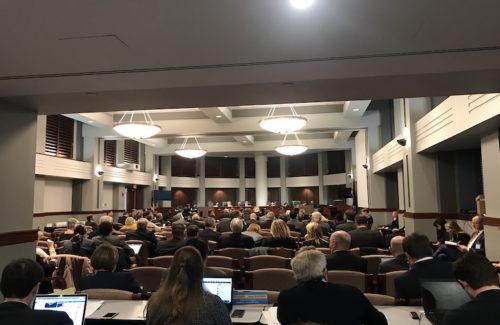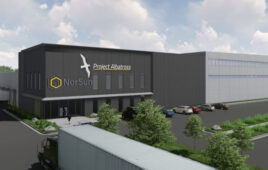The International Trade Commission held its midterm hearing about Section 201 tariffs on crystalline solar panels on December 5. Pro- and anti-tariff advocates packed the large rectangular room to voice their concerns on a sunny winter day in Washington, D.C.
Pro-tariff players and TRQ
A number of domestic module manufacturers led by Suniva shared a few common sentiments. Mission Solar, Auxin Solar, LG Electronics and SunPower said they support keeping the tariffs in place for the remaining two years and oppose a bifacial exclusion.
But those other companies disagreed with Suniva on one major point: All but Suniva want an increase in the number of imported cells that are exempt from tariffs for stateside module assembly (also known as the Trade Rate Quota) from 2.5 GW to at least 5 GW.
Suniva advocated strongly against it because it plans to only manufacture solar cells, not modules, if the comapny restarts. Suniva president Matt Card said selling those U.S.-made cells domestically would be a big challenge if the number of non-taxed imported cells was increased.
Commissioner Rhonda Schmidtlein pressed Suniva on this point, because one reason the company is asking for the TRQ to be left as-is is in the interest of national energy security — so there is a market for cells to be manufactured in the United States and not all internationally.
When commissioners asked about Suniva’s timeline for restarting operations at its Georgia facility, the company said the bifacial exclusion had a “numbing effect” on the process and “put every conversation on pause” as it was attempting to restart. The company plans to add bifacial cell manufacturing capabilities to that facility that it said could be up and running within 100 days if it secures funding.
The announcement that the bifacial exemption was upheld by the U.S. Court of International Trade (CIT) happened during the ITC hearing. Witnesses and commissioners did not appear to be aware of the bifacial exemption update in the morning session, so the impact on Suniva’s business plans was not discussed.
ITC Chairman David Johanson noted Suniva has been “underwater” for a long time. Suniva said “old Suniva” and “old SolarWorld” were underwater, but today, there’s a new generation of solar module producers, and with new entrances come some expected roadblocks.
Anti-tariff advocates
 Representatives from the Canadian, Indonesian and Korean embassies requested that the commission exclude those countries from the 201 tariffs. Canada’s embassy said the safeguard duties have reduced the country’s already-minimal imports to the United States and says that violates the U.S.’s NAFTA commitments.
Representatives from the Canadian, Indonesian and Korean embassies requested that the commission exclude those countries from the 201 tariffs. Canada’s embassy said the safeguard duties have reduced the country’s already-minimal imports to the United States and says that violates the U.S.’s NAFTA commitments.
SEIA and panel manufacturer REC Group spoke out against the tariffs, focusing on the need to remove them to increase jobs and combat global warming.
Counsel for the two groups said most of the new U.S. panel production as a result of the tariffs is devoted to serving residential and commercial markets, leaving the utility market with a very limited supply. The groups asked the commission to terminate or re-calibrate the tariffs.
On a press call a few days before the hearing, SEIA expressed concerns that the result of the midterm hearing would be harsher tariffs. About halfway through the midterm hearing day, this prospect was raised by Commissioner Schmidtlein. She said technically, if President Trump wanted to, he could extend the tariffs beyond two more years. After a pause, a representative from Hanwha Q CELLS responded, “And Q CELLS would support that.”
A report on the midterm tariff review will be given to the president on February 7.
Updated on December 18






Solid report here with the right words in the right order. My name is Jared, and i’m a solar technologist here in the solar boom-town of Salt Lake City, Utah. The Suniva story is an ever developing one with an ever expanding hole of decaying solar modules without an attached warranty. Even more interesting is that according to the Suniva website, the lights all still appear to be on, and the phones all still work.
In an attempt to head off the coming maelstrom of Suniva panel replacement, and all of the difficulties that will accompany it, i’ve been stretching out into the industry for information. How many panels has Suniva sold into the PV market that are now out of warranty? Kelsey, you are in the mix, any ideas on how to track down this number?
Keep up the great research.
-jared
Jered, I have a Suniva solar panel system that is experiencing issues. I have not been able to find anyone from Suniva. My system is still under warranty – as it is 6 years old. Enphase has helped me quit a bit, but aren’t able to get me warranty help. Do you know who, where, or ??? That I can go for help?